Cement-Based Repair Materials and the Interface with Concrete Substrates: Characterization, Evaluation and Improvement
Abstract
1. Introduction
2. Concrete Repair Materials
2.1. Cement-Based Repair Materials
2.2. Alkali-Activated Materials
2.3. Polymer-Modified Mortar Repair Materials
3. Interface between Cement-Based Repair Materials and Concrete Substrate
3.1. Bonding Strength between Cement-Based Repair Materials and Concrete Substrate
3.2. Characterization on the Interfacial Microstructure between Cement-Based Repair Materials and Concrete Substrate
3.3. Technologies for Improving Bond Strength between Cement-Based Repair Materials and Concrete Substrates
4. Summary
Author Contributions
Funding
Institutional Review Board Statement
Informed Consent Statement
Data Availability Statement
Acknowledgments
Conflicts of Interest
References
- Guo, T.; Weng, X.; Liu, C.; Yu, Q.; Zhang, C.; Li, Y. Evaluation of the bonding and fatigue properties of an innovative rapid repair structure for concrete pavement. Constr. Build. Mater. 2020, 235, 117484. [Google Scholar] [CrossRef]
- Napoli, A.; De Felice, G.; De Santis, S.; Realfonzo, R. Bond behaviour of Steel Reinforced Polymer strengthening systems. Compos. Struct. 2016, 152, 499–515. [Google Scholar] [CrossRef]
- Al Hashem, A. Corrosion in the Gulf Cooperation Council (GCC), States: Statistics and Figures; Corrosion UAE: Abu Dhabi, UAE, 2011. [Google Scholar]
- Climent, M.A.; Ortega, J.M.; Sánchez, I. Cement mortars with fly ash and slag—Study of their microstructure and re-sistance to salt ingress in different environmental conditions. In Proceedings of the 3rd International Conference on Concrete Repair, Rehabilitation and Retrofitting (ICCRRR 2012), Cape Town, South Africa, 3–5 September 2012; pp. 3–5. [Google Scholar]
- Ministry of Housing and Urban-Rural Development of the People’s Republic of China (MOHURD), National Expenditure of Urban Maintenance and Construction, 2017. Available online: http://www.mohurd.gov.cn/xytj/index.html (accessed on 13 March 2022).
- Fathy, A.; Zhu, H.; Kohail, M. Factors affecting the fresh-to-hardened concrete repair system. Constr. Build. Mater. 2022, 320, 126279. [Google Scholar] [CrossRef]
- China Building Materials Industry Press. JC/T 2381-2016, People’s Republic of China Building Materials Industry Standard (Repair Mortar); China Building Materials Industry Press: Beijing, China, 2016. [Google Scholar]
- Shaw, M. Guide to the Concrete Repair European Standards BS EN 1504 Series; Sika Limited: Watchmead, Welwyn Garden City, Hertfordshire, UK, 2019. [Google Scholar]
- American Society of Testing Materials. C928/C928M-20, Standard Specification for Packaged, Dry, Rapid-Hardening Cementitious Materials for Concrete Repairs; American Society of Testing Materials: West Conshohocken, PA, USA, 2020. [Google Scholar]
- Cusson, D.; Mailvaganam, N. Durability of repair materials. Concr. Int. Des. Constr. 1996, 18, 34–38. [Google Scholar]
- Qian, J.; You, C.; Wang, Q.; Wang, H.; Jia, X. A method for assessing bond performance of cement-based repair materials. Constr. Build. Mater. 2014, 68, 307–313. [Google Scholar] [CrossRef]
- Popovics, S.; Rajendran, N.; Penko, M. Rapid Hardening Cements for Repair of Concrete. ACI Mater. J. 1987, 84, 64–73. [Google Scholar]
- Cifuentes, H.; Karihaloo, B.L. Analysis of the early-age cracking in concrete made from rapid hardening cement. Hormigón Acero 2018, 69, 101–112. [Google Scholar] [CrossRef]
- Elaty, M.A.A.A. Compressive strength prediction of Portland cement concrete with age using a new model. HBRC J. 2014, 10, 145–155. [Google Scholar] [CrossRef]
- Yu, J.; Qian, J.; Tang, J.; Ji, Z.; Fan, Y. Effect of ettringite seed crystals on the properties of calcium sulphoaluminate cement. Constr. Build. Mater. 2019, 207, 249–257. [Google Scholar] [CrossRef]
- Glasser, F.P.; Zhang, L. High-performance cement matrices based on calcium sulfoaluminate–belite compositions. Cem. Concr. Res. 2001, 31, 1881–1886. [Google Scholar] [CrossRef]
- Al-musawi, H.; Huang, H.; Di Benedetti, M.; Guadagnini, M.; Pilakoutas, K. Effect of shrinkage on rapid hardening plain and recycled steel fibre concrete overlays. Cem. Concr. Compos. 2022, 125, 104246. [Google Scholar] [CrossRef]
- Wagh, A.S. Recent Progress in Chemically Bonded Phosphate Ceramics. ISRN Ceram. 2013, 2013, 983731. [Google Scholar] [CrossRef]
- Sugama, T.; Kukacka, L.E. Characteristics of magnesium polyphosphate cements derived from ammonium polyphosphate solutions. Cem. Concr. Res. 1983, 13, 499–506. [Google Scholar] [CrossRef]
- Arora, A.; Singh, B.; Kaur, P. Novel material i.e., magnesium phosphate cement (MPC) as repairing material in roads and buildings. Mater. Today Proc. 2019, 17, 70–76. [Google Scholar] [CrossRef]
- Abdelrazig, B.E.I.; Sharp, J.H.; El-Jazairi, B. The chemical composition of mortars made from magnesia-phosphate cement. Cem. Concr. Res. 1988, 18, 415–425. [Google Scholar] [CrossRef]
- Qiao, F.; Chau, C.; Li, Z. Property evaluation of magnesium phosphate cement mortar as patch repair material. Constr. Build. Mater. 2010, 24, 695–700. [Google Scholar] [CrossRef]
- Tonelli, M.; Gelli, R.; Ridi, F.; Baglioni, P. Magnesium phosphate-based cements containing Halloysite nanotubes for cracks repair. Constr. Build. Mater. 2021, 301, 124056. [Google Scholar] [CrossRef]
- Schuab, M.R.; dos Santos, W.J.; Borges PH, R. On the development of MK/BFS alkali-activated materials as repair mortars: Performance under free and restrained shrinkage tests. Constr. Build. Mater. 2021, 275, 122109. [Google Scholar] [CrossRef]
- Pacheco-Torgal, F.; Jalali, S. Alkali-activated binders: A review. Constr. Build. Mater. 2008, 22, 1305–1314. [Google Scholar] [CrossRef]
- Heah, C.Y.; Kamarudin, H.; Mustafa Al Bakri, A.M.; Bnhussain, M.; Luqman, M.; Khairul Nizar, I.; Ruzaidi, C.M.; Liew, Y.M. Kaolin-based geopolymers with various NaOH concentrations. Int. J. Miner. Metall. Mater. 2013, 20, 313–322. [Google Scholar] [CrossRef]
- Gomaa, E.; Gheni, A.; ElGawady, M.A. Repair of ordinary Portland cement concrete using ambient-cured alkali-activated concrete: Interfacial behavior. Cem. Concr. Res. 2020, 129, 105968. [Google Scholar] [CrossRef]
- Nunes, V.A.; Borges, P.H.; Zanotti, C. Mechanical compatibility and adhesion between alkali-activated repair mortars and Portland cement concrete substrate. Constr. Build. Mater. 2019, 215, 569–581. [Google Scholar] [CrossRef]
- Ghazy, A.; Bassuoni, M.T. Shrinkage of Nano-modified Fly Ash Concrete as a Repair Material. ACI Mater. J. 2017, 114. [Google Scholar] [CrossRef]
- El-Hawary, M.; Al-Khaiat, H.; Fereig, S. Performance of epoxy-repaired concrete in a marine environment. Cem. Concr. Res. 2000, 30, 259–266. [Google Scholar] [CrossRef]
- Hunkeler, F. The resistivity of pore water solution—A decisive parameter of rebar corrosion and repair methods. Constr. Build. Mater. 1996, 10, 381–389. [Google Scholar] [CrossRef]
- Basunbul, I.A.; Gubati, A.A.; Al-Sulaimani, G.J.; Baluch, M. Repaired reinforced concrete beams. ACI Mater. J. 1990, 87, 348–354. [Google Scholar]
- Aggarwal, L.; Thapliyal, P.; Karade, S. Properties of polymer-modified mortars using epoxy and acrylic emulsions. Constr. Build. Mater. 2007, 21, 379–383. [Google Scholar] [CrossRef]
- Do, J.; Soh, Y. Performance of polymer-modified self-leveling mortars with high polymer–cement ratio for floor finishing. Cem. Concr. Res. 2003, 33, 1497–1505. [Google Scholar] [CrossRef]
- Saccani, A.; Magnaghi, V. Durability of epoxy resin-based materials for the repair of damaged cementitious composites. Cem. Concr. Res. 1999, 29, 95–98. [Google Scholar] [CrossRef]
- Guo, S.Y.; Zhang, X.; Chen, J.Z.; Mou, B.; Shang, H.S.; Wang, P.; Zhang, J.; Ren, J. Mechanical and interface bonding properties of epoxy resin reinforced Portland cement repairing mortar. Constr. Build. Mater. 2020, 264, 120715. [Google Scholar] [CrossRef]
- Ariffin, N.F.; Hussin, M.W.; Sam, A.R.M.; Bhutta, M.A.R.; Khalid, N.H.A.; Mirza, J. Strength properties and molecular composition of epoxy-modified mortars. Constr. Build. Mater. 2015, 94, 315–322. [Google Scholar] [CrossRef]
- Jo, Y. Basic properties of epoxy cement mortars without hardener after outdoor exposure. Constr. Build. Mater. 2008, 22, 911–920. [Google Scholar] [CrossRef]
- Łukowski, P.; Adamczewski, G. Self-repairing of polymer-cement concrete. Bull. Pol. Acad. Sci. Tech. Sci. 2013, 61, 195–200. [Google Scholar] [CrossRef]
- Wang, C.; Wang, Y.; Liu, K.; Zhou, S. Effect of colloid solution concentration of epoxy resin on properties of rust-cracked reinforced concrete repaired by electrophoretic deposition. Constr. Build. Mater. 2022, 318, 126184. [Google Scholar] [CrossRef]
- Esveld, C. Recent developments in slab track. Eur. Railw. Rev. 2003, 9, 81–85. [Google Scholar]
- Le, T.H.M.; Park, D.-W.; Seo, J.-W. Evaluation on the mechanical properties of cement asphalt mortar with quick hardening admixture for railway maintenance. Constr. Build. Mater. 2019, 206, 375–384. [Google Scholar] [CrossRef]
- Fang, L.; Zhou, J.; Yang, Z.; Yuan, Q.; Que, Y. Interaction between cement and asphalt emulsion and its influences on asphalt emulsion demulsification, cement hydration and rheology. Constr. Build. Mater. 2022, 329, 127220. [Google Scholar] [CrossRef]
- Liu, Y.; Wang, F.; Liu, M.; Hu, S. A microstructural approach to adherence mechanism of cement and asphalt mortar (CA mortar) to repair materials. Constr. Build. Mater. 2014, 66, 125–131. [Google Scholar] [CrossRef]
- Wang, R.; Wang, P.M.; Li, X.G. Physical and mechanical properties of styrene–butadiene rubber emulsion modified cement mortars. Cem. Concr. Res. 2005, 35, 900–906. [Google Scholar] [CrossRef]
- Kharazian, H.A.; Zare, M.R.; Noktehdan, M.; Sedaghatdoost, A. Effect of water-based acrylic copolymer on void systems of cementitious repair mortar. Case Stud. Constr. Mater. 2019, 11, e00261. [Google Scholar] [CrossRef]
- Bureau, L.; Alliche, A.; Pilvin, P.; Pascal, S. Mechanical characterization of a styrene–butadiene modified mortar. Mater. Sci. Eng. A 2001, 308, 233–240. [Google Scholar] [CrossRef]
- Li, L.; Wang, R.; Lu, Q. Influence of polymer latex on the setting time, mechanical properties and durability of calcium sulfoaluminate cement mortar. Constr. Build. Mater. 2018, 169, 911–922. [Google Scholar] [CrossRef]
- Alexander, M.G.; Beushausen, H.D.; Dehn, F.; Moyo, P.R. International Conference on Concrete Repair, Retrofitting. In Proceedings of the 3rd International Conference on Concrete Repair, Rehabilitation and Retrofitting (ICCRRR), Cape Town, South Africa, 3–5 September 2012; CRC Press: Boca Raton, FL, USA, 2012. [Google Scholar]
- Luković, M.; Šavija, B.; Dong, H.; Schlangen, E.; Ye, G. Micromechanical Study of the Interface Properties in Concrete Repair Systems. J. Adv. Concr. Technol. 2014, 12, 320–339. [Google Scholar] [CrossRef]
- Luković, M. Influence of Interface and Strain Hardening Cementitious Composite (SHCC) Properties on the Performance of Concrete Repairs; Delft University of Technology: Delft, Netherlands, 2016. [Google Scholar]
- Abu-Tair, A.; Rigden, S.R.; Burley, E. Testing the bond between repair materials and concrete substrate. ACI Mater. J. 1996, 93, 553–558. [Google Scholar]
- Zhou, J.; Ye, G.; Schlangen, E.; van Breugel, K. Modelling of stresses and strains in bonded concrete overlays subjected to differential volume changes. Theor. Appl. Fract. Mech. 2008, 49, 199–205. [Google Scholar] [CrossRef]
- Hassan, K.; Brooks, J.; Al-Alawi, L. Compatibility of repair mortars with concrete in a hot-dry environment. Cem. Concr. Compos. 2001, 23, 93–101. [Google Scholar] [CrossRef]
- Santos, P.E.D.; Júlio, E.N.B.S. Factors Affecting Bond between New and Old Concrete. ACI Mater. J. 2011, 108, 449–456. [Google Scholar]
- Albidah, A.; Abadel, A.; Alrshoudi, F.; Altheeb, A.; Abbas, H.; Al-Salloum, Y. Bond strength between concrete substrate and metakaolin geopolymer repair mortars at ambient and elevated temperatures. J. Mater. Res. Technol. 2020, 9, 10732–10745. [Google Scholar] [CrossRef]
- Garbacz, A.; Piotrowski, T.; Courard, L.; Kwaśniewski, L. On the evaluation of interface quality in concrete repair system by means of impact-echo signal analysis. Constr. Build. Mater. 2017, 134, 311–323. [Google Scholar] [CrossRef]
- Tayeh, B.A.; Bakar, B.A.; Johari, M.M.; Voo, Y.L. Mechanical and permeability properties of the inter-face between normal concrete substrate and ultra high performance fiber concrete overlay. Constr. Build. Mater. 2012, 36, 538–548. [Google Scholar] [CrossRef]
- Qin, J.; Qian, J.; You, C.; Fan, Y.; Li, Z.; Wang, H. Bond behavior and interfacial micro-characteristics of magnesium phosphate cement onto old concrete substrate. Constr. Build. Mater. 2018, 167, 166–176. [Google Scholar] [CrossRef]
- Gadri, K.; Guettala, A. Evaluation of bond strength between sand concrete as new repair material and ordinary concrete substrate (The surface roughness effect). Constr. Build. Mater. 2017, 157, 1133–1144. [Google Scholar] [CrossRef]
- Kim, H.Y.; Han, D.; Kim, K.; Romero, P. Performance assessment of repair material for deteriorated concrete slabs using chemically bonded cement. Constr. Build. Mater. 2019, 237, 117468. [Google Scholar] [CrossRef]
- Feng, S.; Xiao, H.; Li, H. Comparative studies of the effect of ultrahigh-performance concrete and normal con-crete as repair materials on interfacial bond properties and microstructure. Eng. Struct. 2020, 222, 111122. [Google Scholar] [CrossRef]
- Sadrmomtazi, A.; Khoshkbijari, R.K. Determination and Prediction of Bonding Strength of Polymer Modified Concrete (PMC) as the Repair Overlay on the Conventional Concrete Substrate. KSCE J. Civ. Eng. 2019, 23, 1141–1149. [Google Scholar] [CrossRef]
- Zhang, X.; Li, G.; Song, Z. Influence of styrene-acrylic copolymer latex on the mechanical properties and micro-structure of Portland cement/Calcium aluminate cement/Gypsum cementitious mortar. Constr. Build. Mater. 2019, 227, 116666. [Google Scholar] [CrossRef]
- Julio, E.N.; Branco, F.A.; Silva, V.D. Concrete-to-concrete bond strength. Influence of the roughness of the substrate surface. Constr. Build. Mater. 2004, 18, 675–681. [Google Scholar] [CrossRef]
- Bentz, D.P.; De la Varga, I.; Muñoz, J.F.; Spragg, R.P.; Graybeal, B.A.; Hussey, D.S.; Jacobson, S.Z.; Jones, J.M.; LaManna, J.M. Influence of substrate moisture state and roughness on interface microstructure and bond strength: Slant shear vs. pull-off testing. Cem. Concr. Compos. 2018, 87, 63–72. [Google Scholar] [CrossRef]
- He, Y.; Zhang, X.; Hooton, R.D.; Zhang, X. Effects of interface roughness and interface adhesion on new-to-old concrete bonding. Constr. Build. Mater. 2017, 151, 582–590. [Google Scholar] [CrossRef]
- Wang, L.; Guo, F.X.; Yang, H.M.; Wang, Y.; Tang, S.W. Comparison of FLY ASH, PVA Fiber, MgO and Shrinkage-reducing Admixture on the Frost Resistance of Face Slab Concrete via Pore Structural and Fractal Analysis. Fractals 2020, 29, 2140002. [Google Scholar] [CrossRef]
- Wang, L.; Jin, M.M.; Guo, F.X.; Wang, Y.; Tang, S.W. Pore Structural and Fractal Analysis of the Influence of FLY ASH and Silica Fume on the Mechanical Property and Abrasion Resistance of Concrete. Fractals 2020, 29, 2140003. [Google Scholar] [CrossRef]
- Wang, L.; Luo, R.; Zhang, W.; Jin, M.; Tang, S. Effects of Fineness and Content of Phosphorus Slag on Cement Hydration, Permeability, Pore Structure and Fractal Dimension of Concrete. Fractals 2020, 29, 2140004. [Google Scholar] [CrossRef]
- Zhang, Y.; Zhu, P.; Liao, Z.; Wang, L. Interfacial bond properties between normal strength concrete substrate and ultra-high performance concrete as a repair material. Constr. Build. Mater. 2020, 235, 117431. [Google Scholar] [CrossRef]
- Pang, B.; Zhang, Y.; Liu, G.; She, W. Interface Properties of Nanosilica-Modified Waterborne Epoxy Cement Repairing System. ACS Appl. Mater. Interfaces 2018, 10, 21696–21711. [Google Scholar] [CrossRef]
- Sadowski, Ł.; Stefaniuk, D.; Żak, A.M.; Krakowiak, K.J. Micromechanical properties within the interphase between heterogeneous layers made of cementitious composites. Constr. Build. Mater. 2019, 215, 1033–1043. [Google Scholar] [CrossRef]
- Brzozowski, P.; Horszczaruk, E. Influence of surface preparation on adhesion of underwater repair concretes under hydrostatic pressure. Constr. Build. Mater. 2021, 310, 125153. [Google Scholar] [CrossRef]
- Feng, S.; Xiao, H.; Geng, J. Bond strength between concrete substrate and repair mortar: Effect of fibre stiffness and substrate surface roughness. Cem. Concr. Compos. 2020, 114, 103746. [Google Scholar] [CrossRef]
- Yazdi, M.A.; Dejager, E.; Debraekeleer, M.; Gruyaert, E.; Van Tittelboom, K.; De Belie, N. Bond strength between concrete and repair mortar and its relation with concrete removal techniques and substrate composition. Constr. Build. Mater. 2020, 230, 116900. [Google Scholar] [CrossRef]
- Lukovic, M.; Ye, G. Effect of Moisture Exchange on Interface Formation in the Repair System Studied by X-ray Absorption. Materials 2015, 9, 2. [Google Scholar] [CrossRef]
- Courard, L.; Lenaers, J.F.; Michel, F.; Garbacz, A. Saturation level of the superficial zone of concrete and adhesion of repair systems. Constr. Build. Mater. 2011, 25, 2488–2494. [Google Scholar] [CrossRef]
- Zanotti, C.; Rostagno, G.; Tingley, B. Further evidence of interfacial adhesive bond strength enhancement through fiber reinforcement in repairs. Constr. Build. Mater. 2018, 160, 775–785. [Google Scholar] [CrossRef]
- Liu, J.; Liu, W.; Guan, S.; Guo, C.; Zheng, A.X. Use of polypropylene fiber and silica fume modified concrete as a repair material. MATEC Web Conf. 2018, 199, 07008. [Google Scholar] [CrossRef][Green Version]
- Huseien, G.F.; Mirza, J.; Ismail, M.; Ghoshal, S.K.; Hussein, A.A. Geopolymer mortars as sustainable repair material: A comprehensive review. Renew. Sustain. Energy Rev. 2017, 80, 54–74. [Google Scholar] [CrossRef]
- Espeche, A.D.; León, J. Estimation of bond strength envelopes for old-to-new concrete interfaces based on a cylinder splitting test. Constr. Build. Mater. 2011, 25, 1222–1235. [Google Scholar] [CrossRef]
- Neves, I.B.; Chabut, M.; Perruchot, C.; Chehimi, M.M.; Benzarti, K. Interfacial interactions of structural adhesive components with cement pastes: Studies by inverse gas chromatography (IGC). Appl. Surf. Sci. 2004, 238, 523–529. [Google Scholar] [CrossRef]
- Tatar, J.; Torrence, C.E.; Mecholsky, J.J.; Taylor, C.R.; Hamilton, H. Effects of silane surface functionalization on interfacial fracture energy and durability of adhesive bond between cement paste and epoxy. Int. J. Adhes. Adhes. 2018, 84, 132–142. [Google Scholar] [CrossRef]
- Xiong, G.; Liu, J.; Li, G.; Xie, H. A way for improving interfacial transition zone between concrete substrate and repair materials. Cem. Concr. Res. 2002, 32, 1877–1881. [Google Scholar] [CrossRef]
- Ma, C.-K.; Apandi, N.M.; Sofrie, C.S.Y.; Ng, J.H.; Lo, W.H.; Awang, A.Z.; Omar, W. Repair and rehabilitation of concrete structures using confinement: A review. Constr. Build. Mater. 2017, 133, 502–515. [Google Scholar] [CrossRef]
- Zhou, J.; Ye, G.; van Breugel, K. Cement hydration and microstructure in concrete repairs with cementitious repair materials. Constr. Build. Mater. 2016, 112, 765–772. [Google Scholar] [CrossRef]
- Beushausen, H.; Höhlig, B.; Talotti, M. The influence of substrate moisture preparation on bond strength of concrete overlays and the microstructure of the OTZ. Cem. Concr. Res. 2017, 92, 84–91. [Google Scholar] [CrossRef]
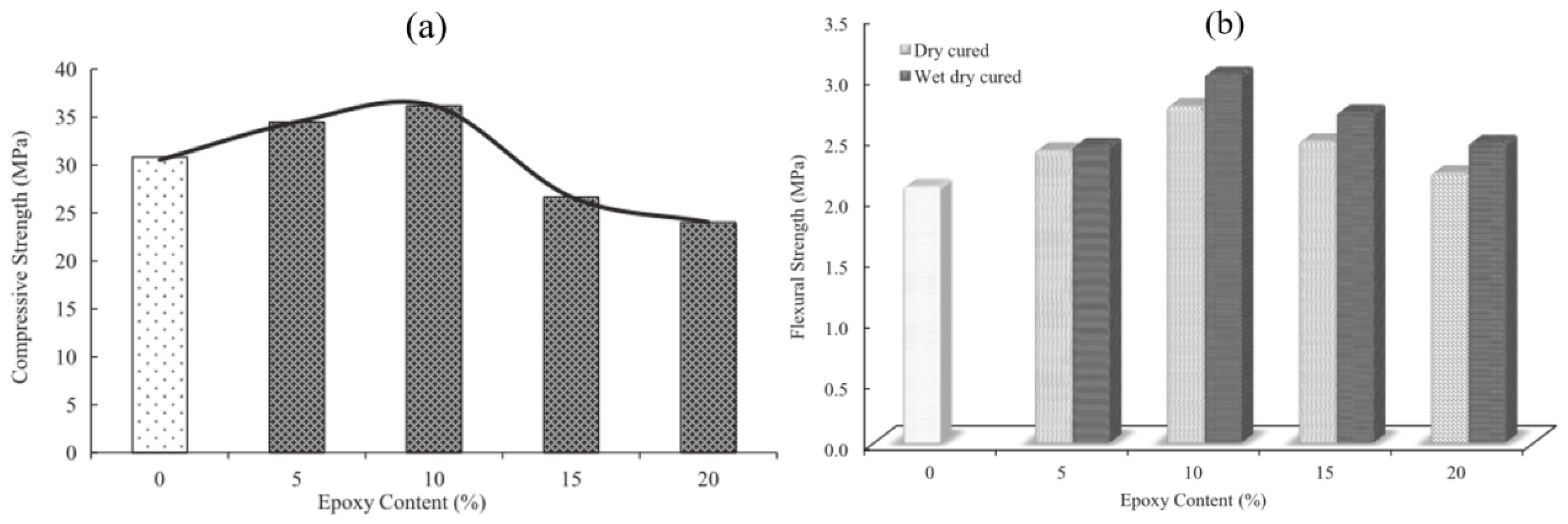

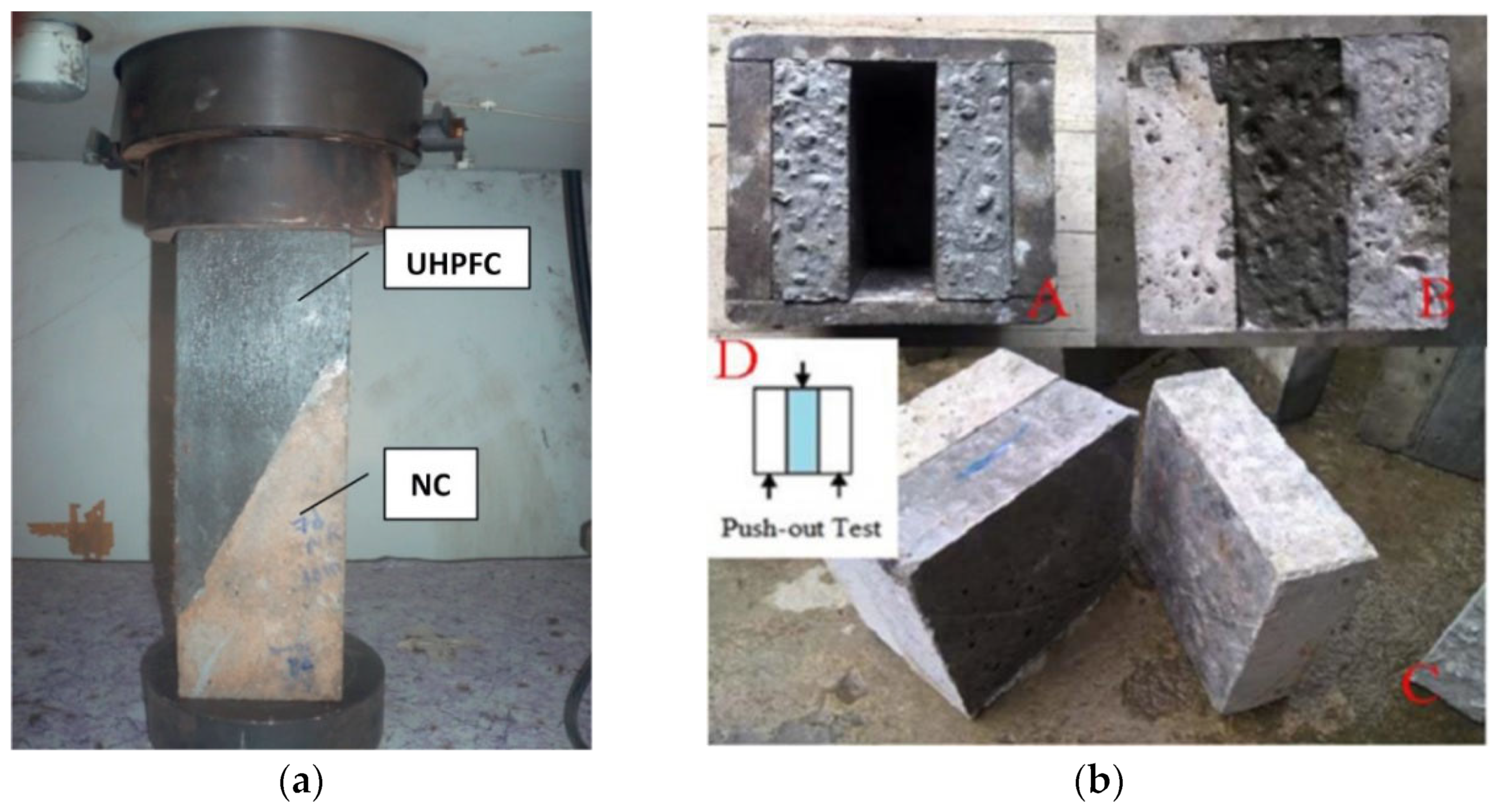
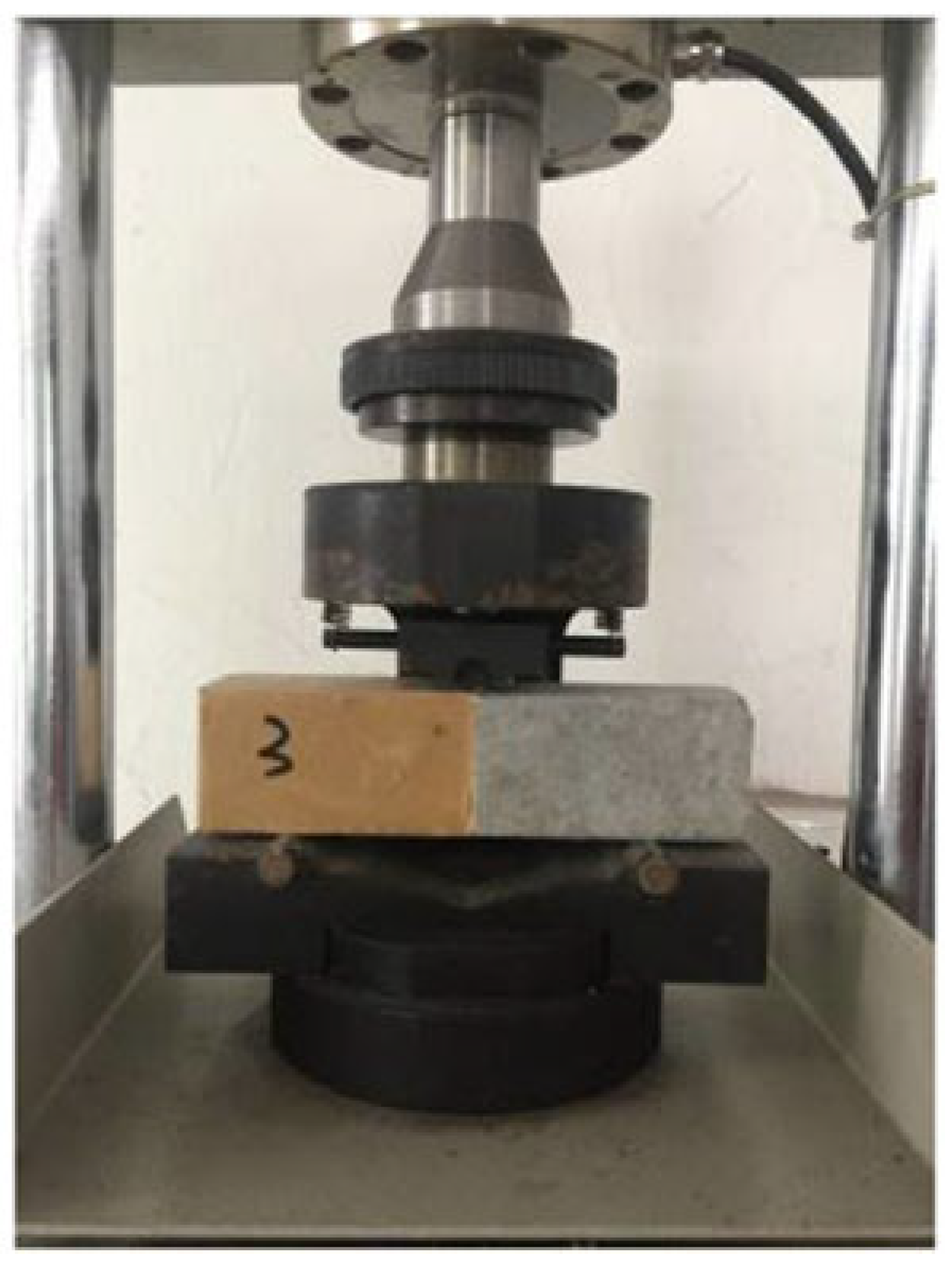
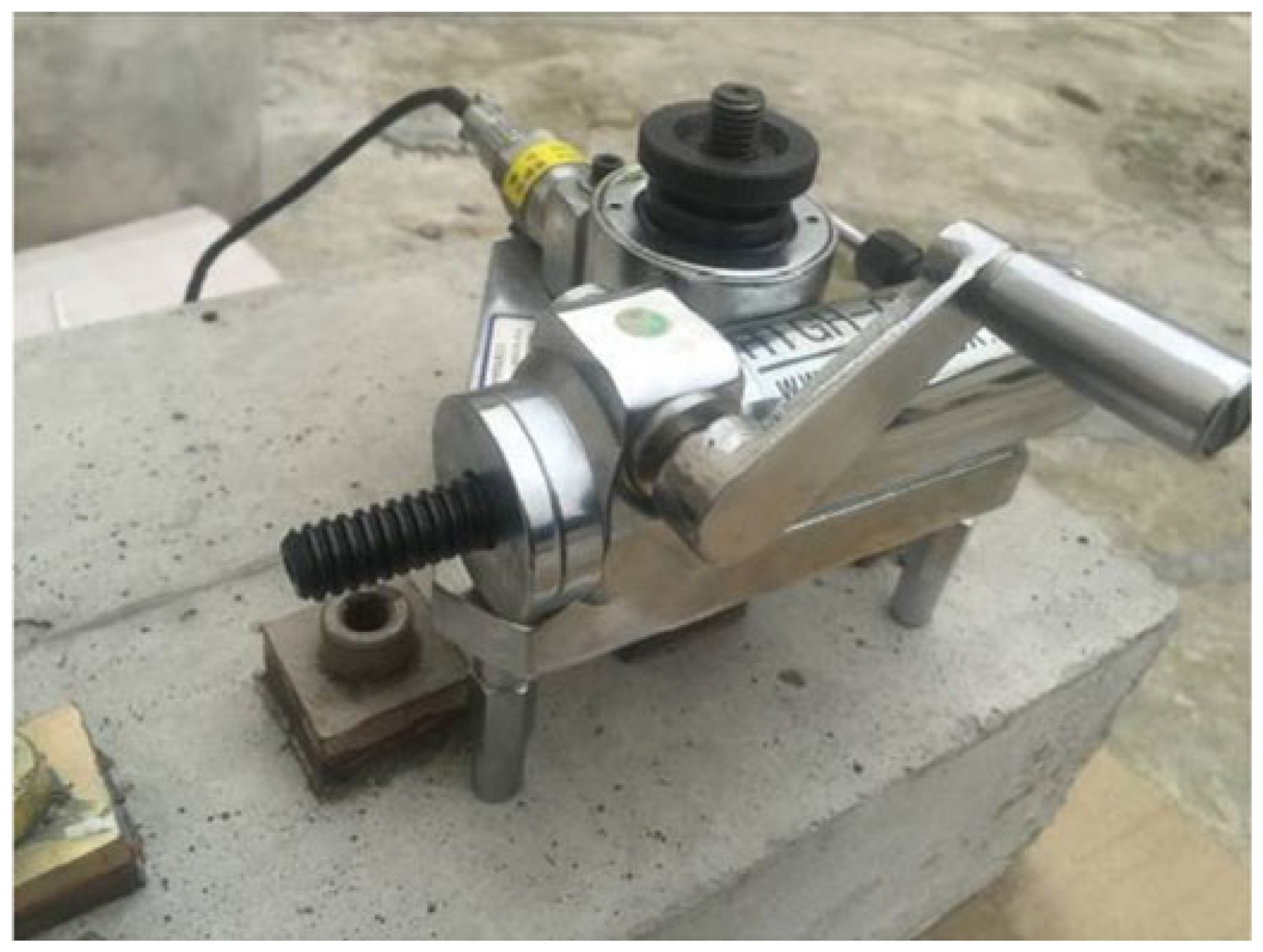
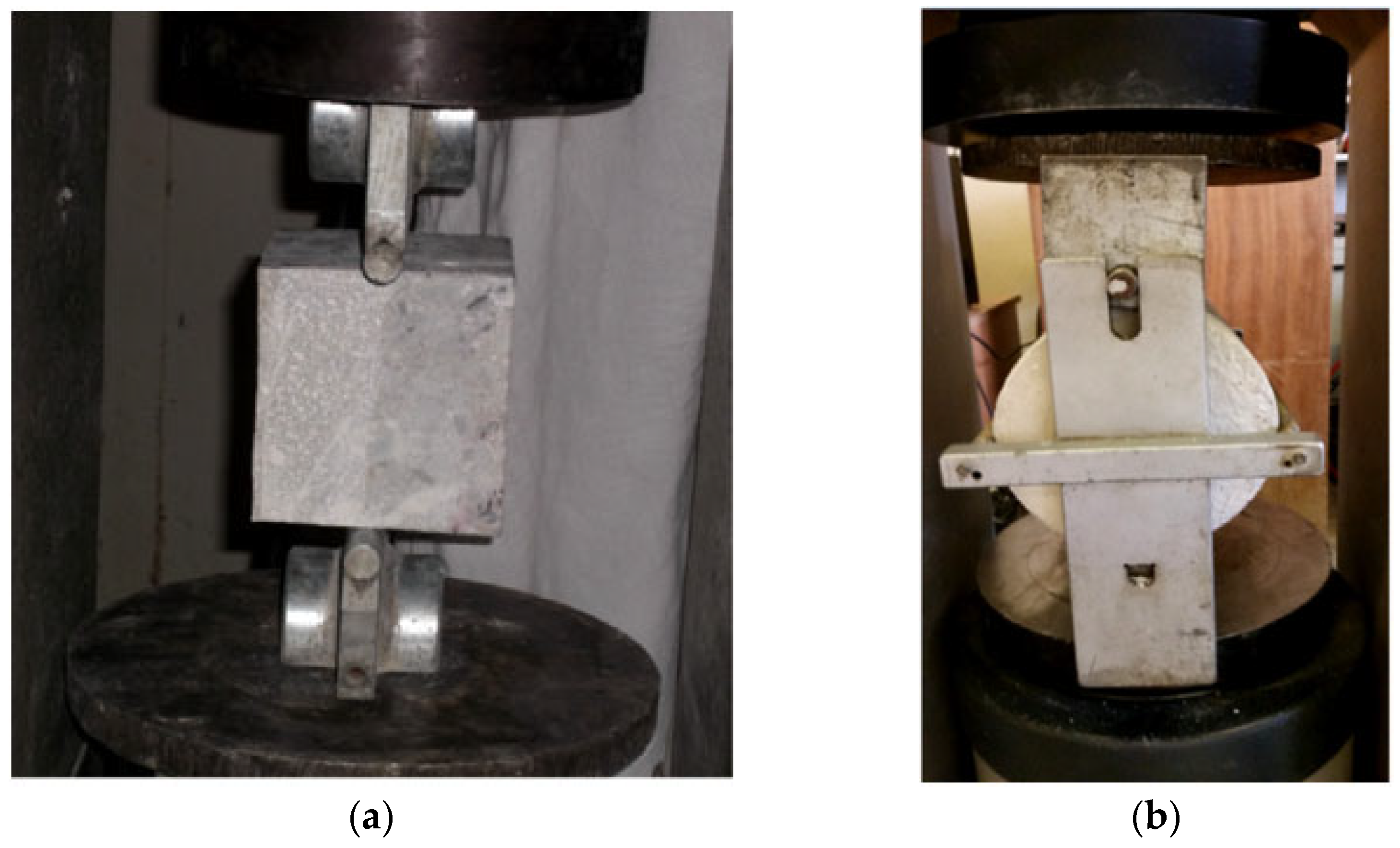



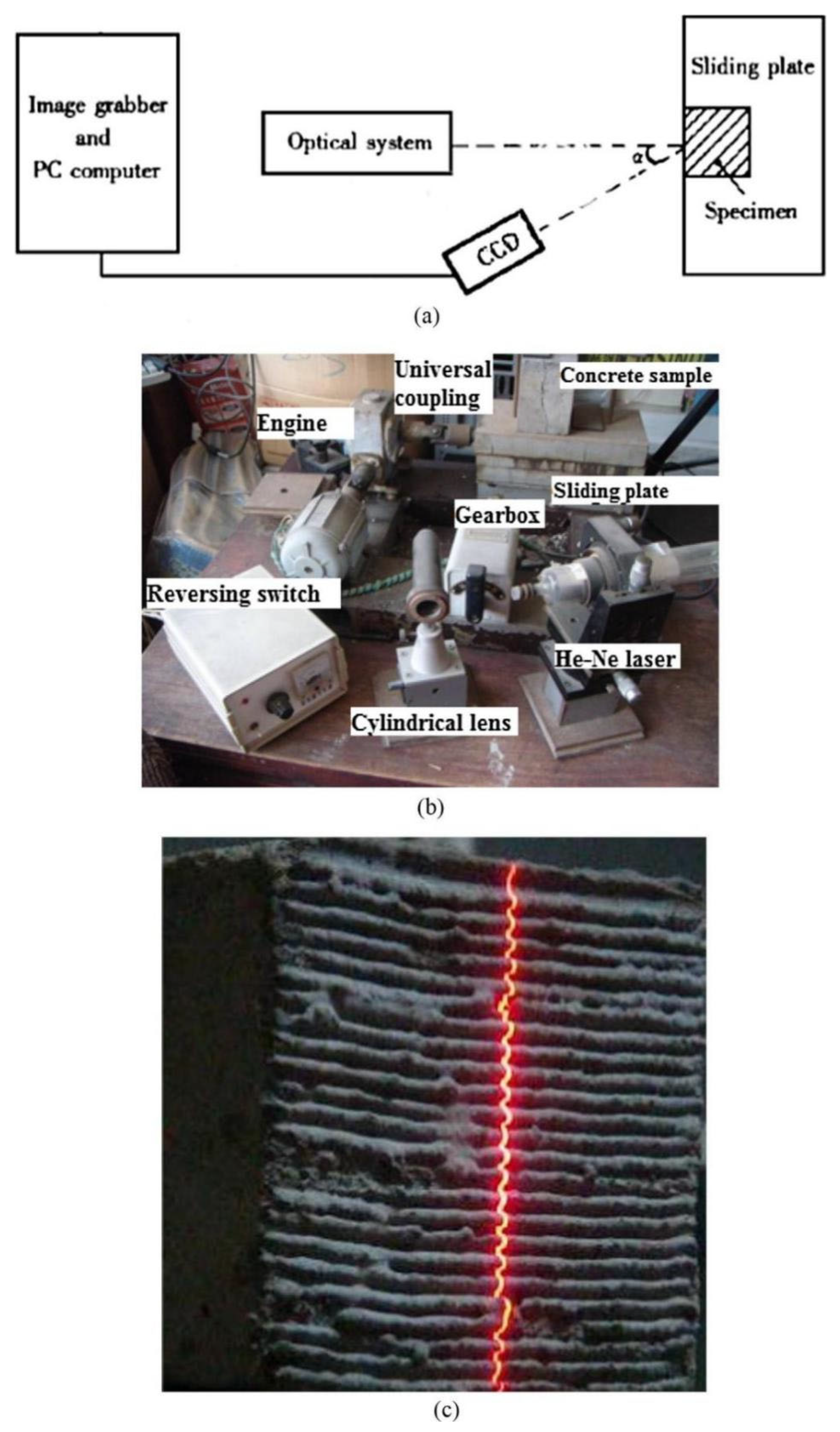
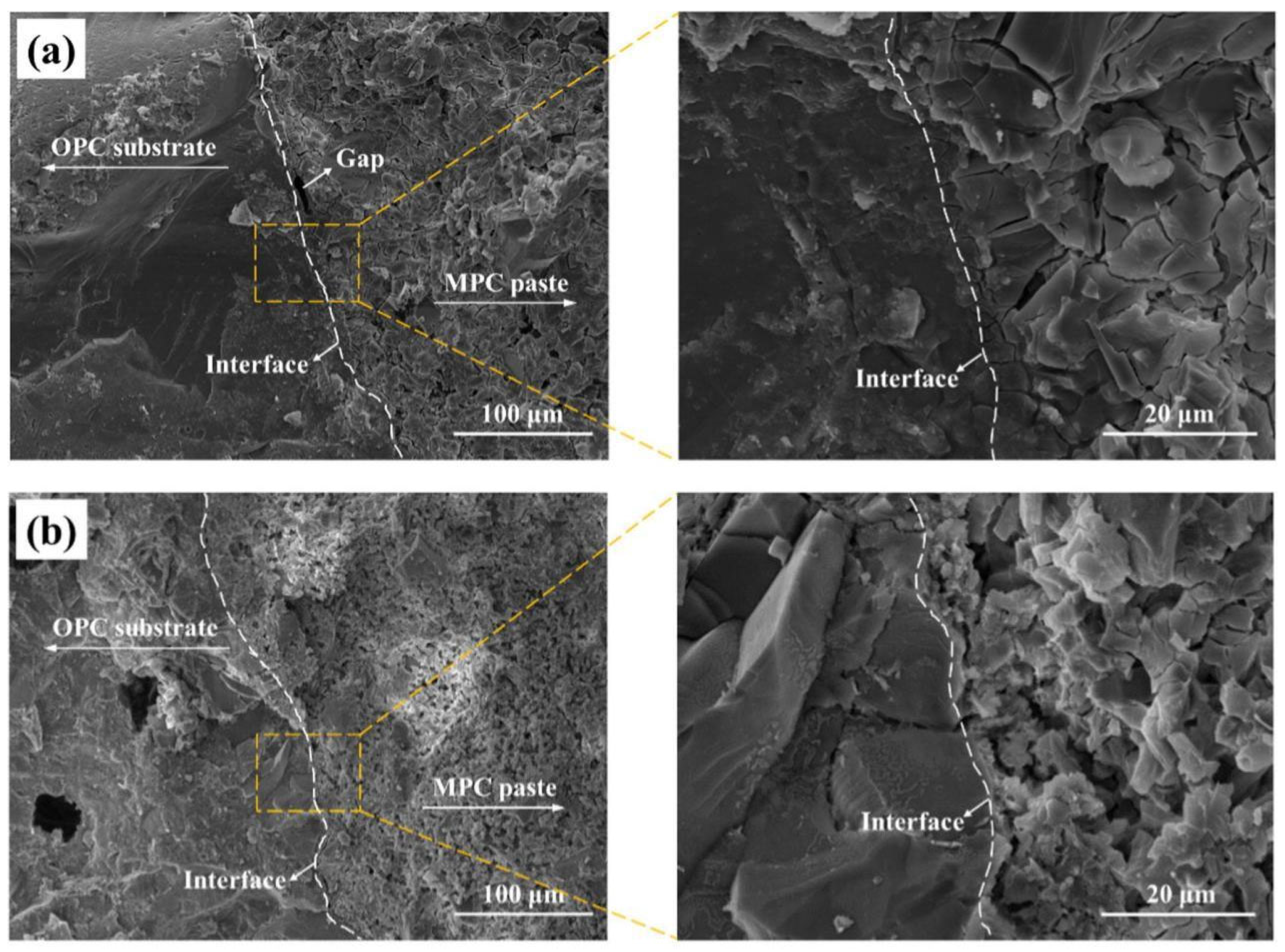
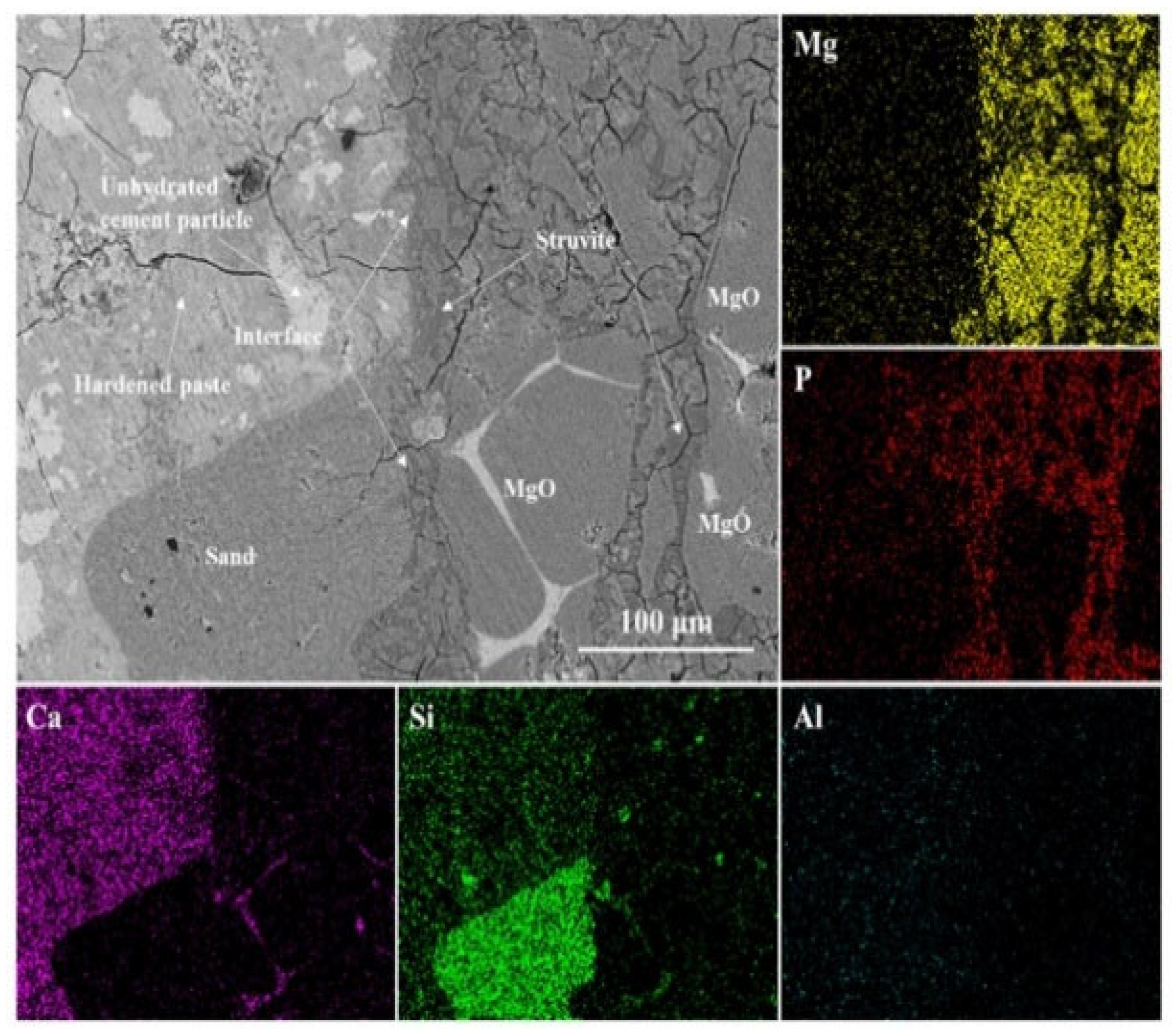

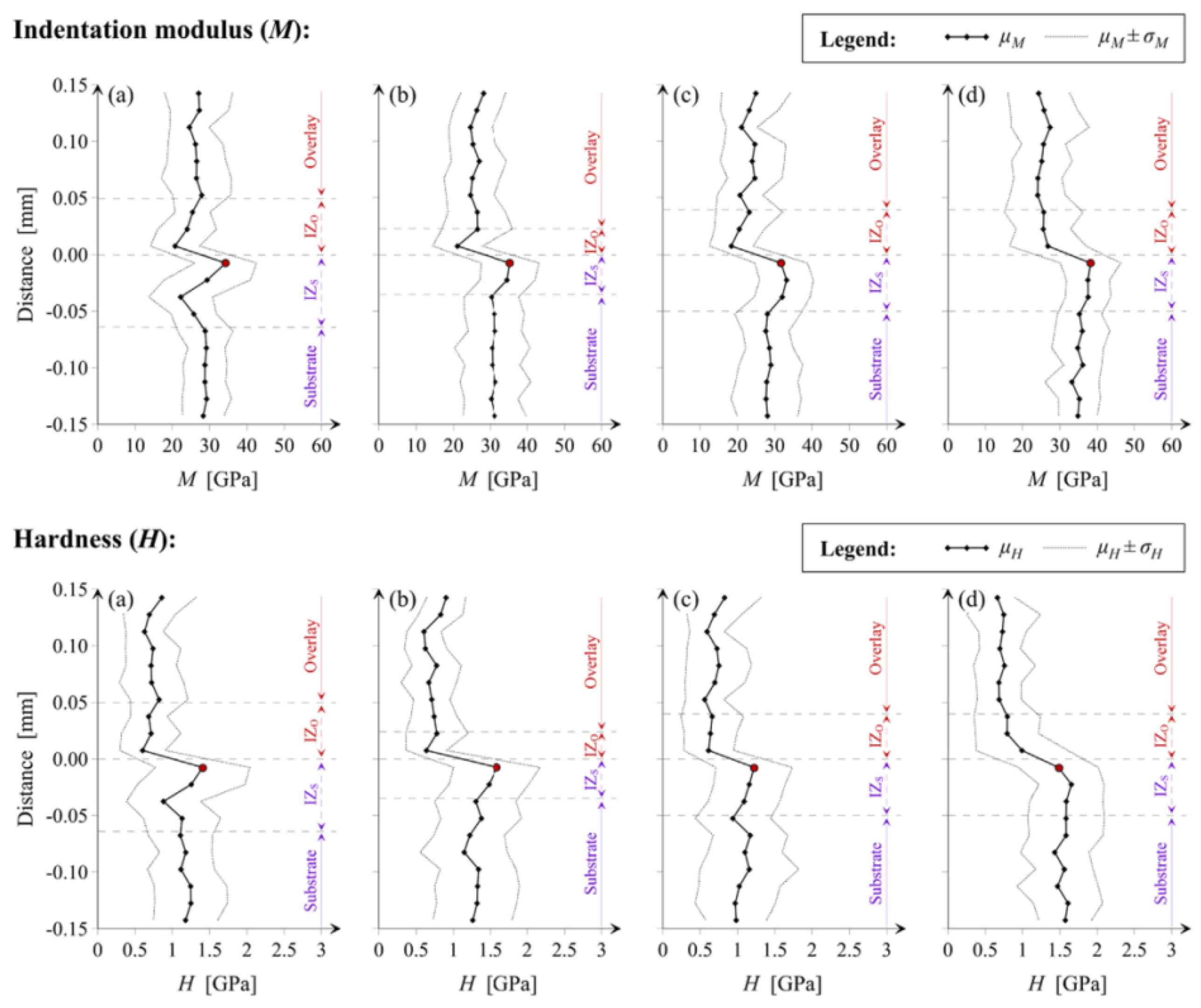


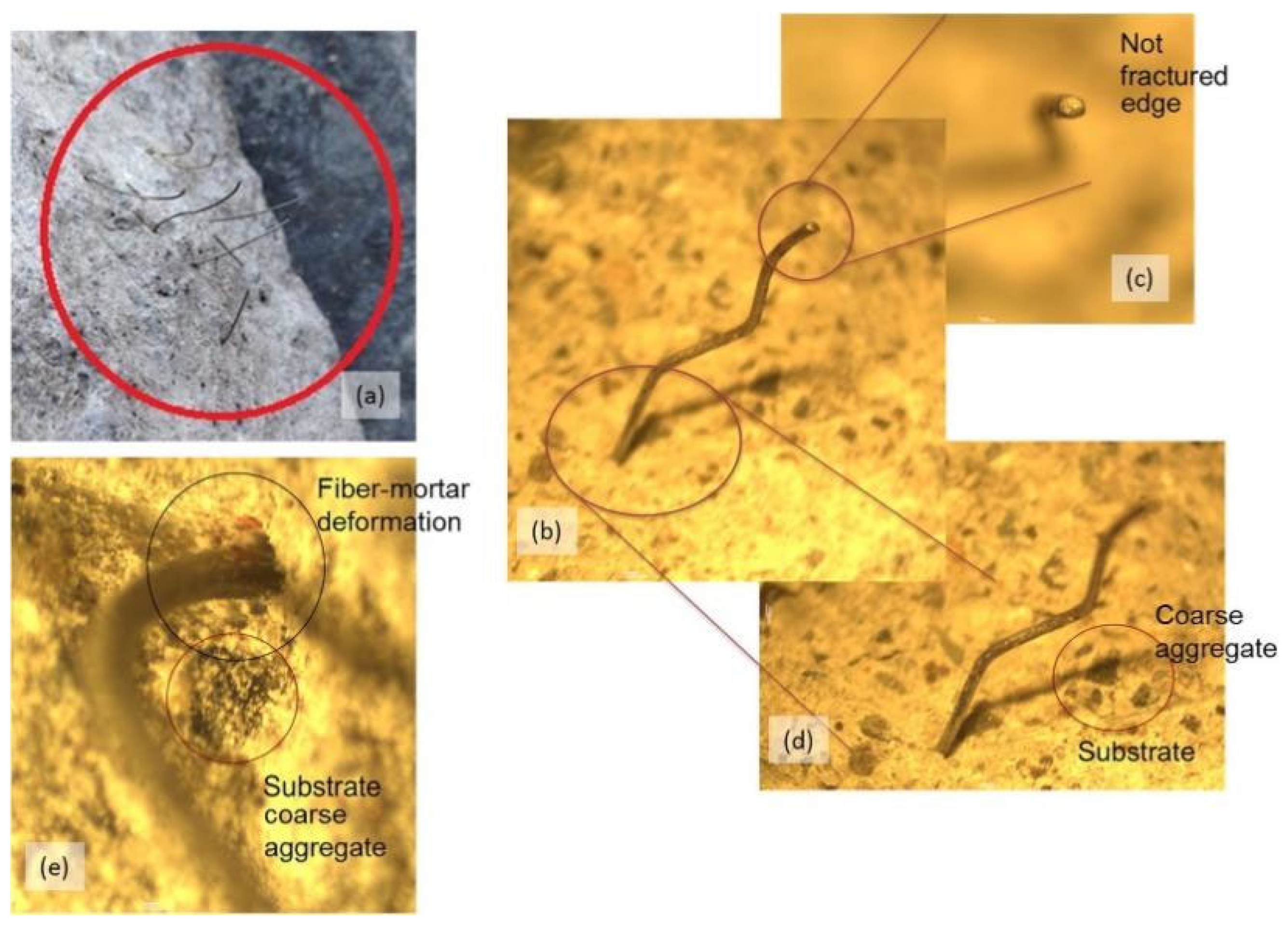
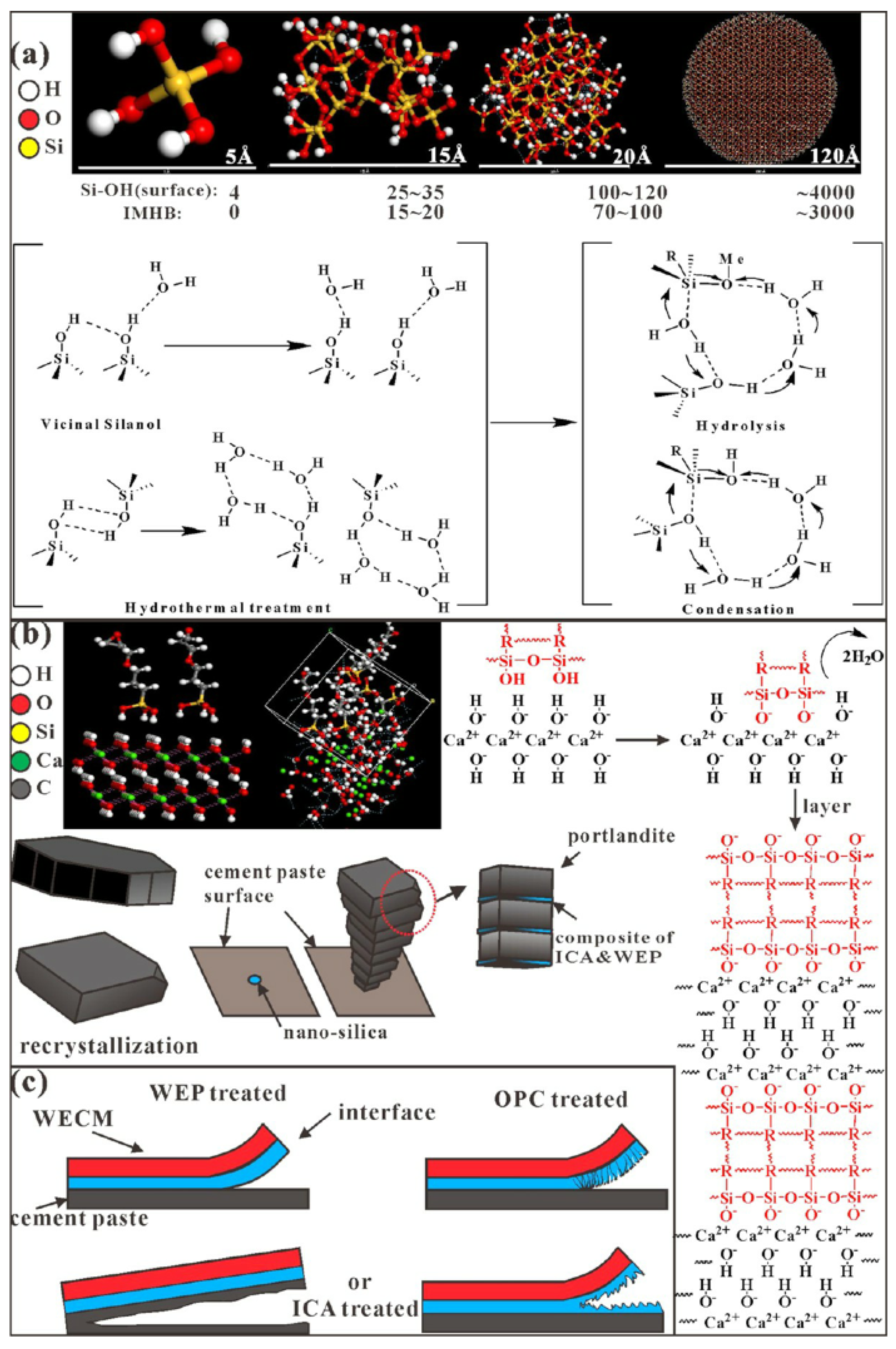
| Concrete Type | Compressive Strength (MPa) | Flexural Strength (MPa) | Compressive Flexure Ratio | Stretching Bond Strength (MPa) | Rate of Drying Shrinkage (%) |
|---|---|---|---|---|---|
| 28 Days | 28 Days | 28 Days | 14 Days | 28 Days | |
| NF | ≥20.0 | ≥5.0 | ≤4.0 | ≥0.8 | ≤0.1 |
| NS | ≥30.0 | ≥6.0 | ≤7.0 | ≤1.0 |
| Item | Requirement | |||
|---|---|---|---|---|
| Structural | Non-Structural | |||
| Class R4 | Class R3 | Class R2 | Class R1 | |
| Compressive Strength at 7 days | ≥45 MPa | ≥25 MPa | ≥15 MPa | ≥10 MPa |
| Chloride Ion Content | ≤0.05% | ≤0.05% | ||
| Adhesive Bond at 7days | ≥2.0 MPa | ≥1.5 MPa | ≥0.8 MPa | |
| Restrained shrinkage Expansion | Max average crack width < 0.05 mm No crack width > 0.1 mm No delamination | No requirement | ||
| ≥2.0 MPa | ≥1.5 MPa | ≥0.8 MPa | ||
| Durability Carbonation Resistance (not required if coated) | dk ≤ Control concrete C (0.45) | Not required | ||
| Elastic Modulus | ≥20 GPa | ≥15 GPa | Not required | |
| Time | 3 h | 1 Day | 7 Days | 28 Days |
|---|---|---|---|---|
| Compressive strength min, MPa | ||||
| R1 concrete or mortar | 3.5 | 14 | 28 | ≥28 |
| R2 concrete or mortar | 7.0 | 21 | 28 | ≥28 |
| R3 concrete or mortar | 21 | 35 | 35 | ≥35 |
| Bond strength min, MPa | ||||
| R1, R2 and R3 concrete or mortar | - | 7 | 10 | - |
| Length change, based on length at 3 h max | ||||
| R1, R2 and R3 concrete or mortar | allowable increase after 28 days in water | −0.15% | ||
| allowable increase after 28 days in air | +0.15% | |||
| Reference | Mix Proportion | Performance | ||
|---|---|---|---|---|
| Cement:Sand:Water:Reducer | Setting Time/Min | Compressive Strength at 1 Days/MPa | Flexural Bond Strength at 7 Days/MPa | |
| [11] | 1:1.5:0.25:0.01 | >180 | 22 | 4.8 |
| [13] | 1:0.09:-:- | 28 | 42.8 | - |
| Reference | Mix Proportion | Performance | ||
|---|---|---|---|---|
| Cement:Sand:Water:Reducer | Setting Time/Min | Compressive Strength at 1 Days/MPa | Flexural Bond Strength at 7 Days/MPa | |
| [11] | 1:1.5:0.25:0.01 | 15 | 50 | 7.8 |
| [15] | 1:-:0.3:- | 27 | 40.2 | - |
| 1:-:0.28:- | 12 | 63 | - | |
| Reference | Mix Proportion | Performance | ||
|---|---|---|---|---|
| Cement:Sand:Water | Setting Time/Min | Compressive Strength at 7 Days/MPa | Flexural Bond Strength at 7 Days/MPa | |
| [22] | 1:1.5:0.2 (M/P = 6) | 11.25 | 61.8 | 9.1 |
| 1:1.5:0.2 (M/P = 8) | 8 | 28 | 4 | |
| 1:1.5:0.2 (M/P = 10) | 7.25 | 37 | 4.6 | |
| [11] | 1:1.5:0.12 | 22 | 33 | 4.3 |
| Reference | Mix Proportion | Performance | |||
|---|---|---|---|---|---|
| MK (%):BFS (%) | W/B a | Compressive Strength at 7 Days/MPa | Bond Strength at 7 Days/MPa | ||
| Flexural Bond Strength | Vertical Bond Stress | ||||
| [28] | 100:0 | - | 49.3 | 1.78 | - |
| 80:20 | - | 50 | 1.74 | - | |
| 60:40 | - | 56.7 | 1.3 | - | |
| [27] | - | 0.36 | 37 | - | 26 |
| - | 0.39 | 33 | - | 23 | |
| - | 0.54 | 34 | - | 24.5 | |
| Reference | Mix Proportion | Performance | ||
|---|---|---|---|---|
| Cement:Sand:Water:Epoxy Resin | Compressive Strength at 7 Days/MPa | Flexural Strength at 7 Days/MPa | Flexural Bond Strength at 28 Days/MPa | |
| [36] | 1:2:0.36:0.03 | 49 | 9.5 | 3.8 |
| 1:2:0.36:0.05 | 50 | 9.8 | 4.9 | |
| 1:2:0.36:0.07 | 49.8 | 9.6 | 4.7 | |
| 1:2:0.36:0.09 | 49.5 | 9.4 | 4.6 | |
| Reference | Mix Proportion | Performance | ||
|---|---|---|---|---|
| Cement:Sand:Water:Asphalt Emulsion | Unconfined Compressive Strength at 28 Days/MPa | Setting Time/Min | Flexural Bond Strength at 4 h/MPa | |
| [42] | 1:0.5:0.4:0.75 | 4.1 | 17 | -- |
| 1:0.5:0.4:1 | 3.4 | 21 | -- | |
| 1:0.5:0.4:1.25 | 1.8 | 24 | - | |
| 1:-:0.4:0.75 | 2.2 | 20 | - | |
| 1:-:0.4:1 | 2.1 | 25 | - | |
| 1:-:0.4:1.25 | 1.7 | 37.5 | - | |
| Sulphoaluminate cement:sand:water:asphalt emulsion | Unconfined compressive strength at 28 days/MPa | Setting time/min | Flexural bond strength at 4 h/MPa | |
| [44] | 1:2.2:0.52:0 | - | - | 2.65 |
| 1:2.2:0.52:0.1 | - | - | 2.33 | |
| 1:2.2:0.52:0.3 | - | - | 2.12 | |
| 1:2.2:0.52:0.5 | - | - | 1.87 | |
| 1:2.2:0.52:0.7 | - | - | 0.99 | |
Publisher’s Note: MDPI stays neutral with regard to jurisdictional claims in published maps and institutional affiliations. |
© 2022 by the authors. Licensee MDPI, Basel, Switzerland. This article is an open access article distributed under the terms and conditions of the Creative Commons Attribution (CC BY) license (https://creativecommons.org/licenses/by/4.0/).
Share and Cite
Song, X.; Song, X.; Liu, H.; Huang, H.; Anvarovna, K.G.; Ugli, N.A.D.; Huang, Y.; Hu, J.; Wei, J.; Yu, Q. Cement-Based Repair Materials and the Interface with Concrete Substrates: Characterization, Evaluation and Improvement. Polymers 2022, 14, 1485. https://doi.org/10.3390/polym14071485
Song X, Song X, Liu H, Huang H, Anvarovna KG, Ugli NAD, Huang Y, Hu J, Wei J, Yu Q. Cement-Based Repair Materials and the Interface with Concrete Substrates: Characterization, Evaluation and Improvement. Polymers. 2022; 14(7):1485. https://doi.org/10.3390/polym14071485
Chicago/Turabian StyleSong, Xuemin, Xiongfei Song, Hao Liu, Haoliang Huang, Kasimova Guzal Anvarovna, Nurmirzayev Azizbek Davlatali Ugli, Yi Huang, Jie Hu, Jiangxiong Wei, and Qijun Yu. 2022. "Cement-Based Repair Materials and the Interface with Concrete Substrates: Characterization, Evaluation and Improvement" Polymers 14, no. 7: 1485. https://doi.org/10.3390/polym14071485
APA StyleSong, X., Song, X., Liu, H., Huang, H., Anvarovna, K. G., Ugli, N. A. D., Huang, Y., Hu, J., Wei, J., & Yu, Q. (2022). Cement-Based Repair Materials and the Interface with Concrete Substrates: Characterization, Evaluation and Improvement. Polymers, 14(7), 1485. https://doi.org/10.3390/polym14071485









